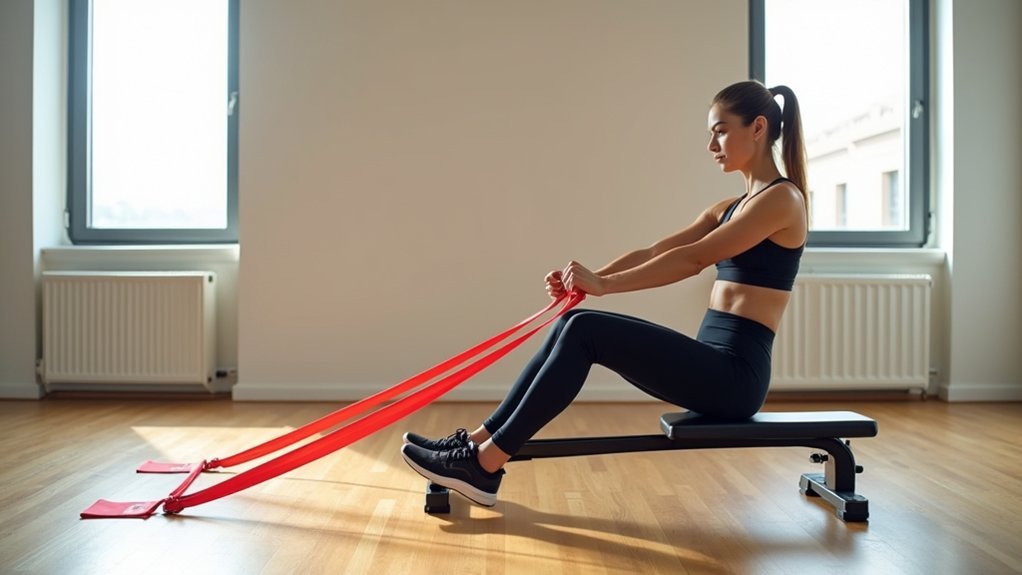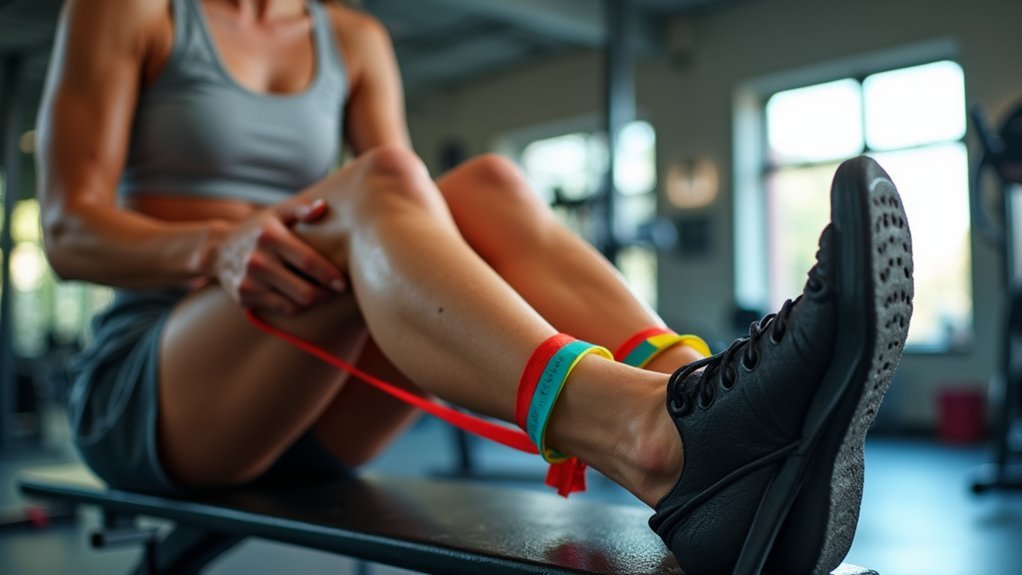You’ll discover a transformative approach to fitness that eliminates traditional workout barriers through seated resistance band circuits. If mobility challenges or limited space have previously restricted your exercise options, these targeted movements offer a precise, full-body solution. By strategically employing resistance bands while seated, you’ll engage multiple muscle groups with controlled, low-impact techniques. Want to understand how these compact workouts can revolutionize your strength training and rehabilitation potential?
Key Takeaways
- Full-body seated resistance band circuits efficiently target multiple muscle groups by strategically combining upper and lower body movements from a stable chair position.
- Effective circuits progressively increase resistance levels, incorporating shoulder raises, bicep curls, leg extensions, and hip movements to challenge strength across different muscle zones.
- Proper setup requires a sturdy chair, appropriately sized resistance band (1.2-1.5 meters), and focused attention on maintaining correct posture throughout each exercise sequence.
- Safe workout progression involves starting with lower resistance, performing controlled movements, implementing warm-up and cool-down routines, and listening to individual physical responses.
- Comprehensive seated band circuits can be customized for varied fitness levels by adjusting band tension, repetition counts, and exercise complexity to match individual strength capabilities.
Understanding Seated Resistance Band Workouts

Precision meets versatility in seated resistance band workouts, a strategic approach to fitness that transforms any chair into a thorough exercise platform. These methodical circuits leverage body resistance to target upper body and muscle groups efficiently, providing a low-impact strengthening method for individuals with varied mobility capabilities.
Your resistance band becomes an all-encompassing fitness tool, measuring 1.2 to 1.5 meters, enabling targeted muscle engagement while maintaining proper seated posture. The approach prioritizes controlled movements, systematic muscle activation, and progressive resistance training. By anchoring exercises around a stable chair, you’ll guarantee consistent form, minimize injury risk, and maximize muscular recruitment across multiple muscle groups.
The workout’s clinical design allows for adaptable, precise muscle conditioning without excessive joint stress.
Essential Equipment and Setup

Three key components form the foundation of an effective seated resistance band workout: a sturdy chair, a high-quality resistance band, and your focused intention. Select a chair that provides stable support and allows you to maintain proper posture throughout your exercise routine. Choose a resistance band measuring 1.2 to 1.5 meters, ensuring it can accommodate full-body movements while providing adequate tension.
Maximize your seated resistance band workout with the right chair, band, and focused intent for optimal strength training.
Key considerations for ideal setup include:
- Position yourself at the chair’s edge to engage core muscles actively
- Anchor the resistance band securely to prevent unexpected slipping
- Maintain an upright posture with shoulders back and spine aligned
Precise equipment selection and strategic positioning are critical for maximizing the effectiveness of your seated resistance band workout, enabling thorough strength training while minimizing injury risk.
Proper Warm-Up Techniques

Before diving into resistance band exercises, you’ll want to prepare your body systematically through a targeted warm-up routine. Feel free to start with gentle stretches that increase blood flow and flexibility, focusing on your upper back and shoulder regions. Perform arm circles and overhead reaches to activate key muscle groups, maintaining a neutral spine position throughout.
Incorporate band-specific movements like arm openings and external rotations to prime your shoulder muscles for resistance training. These controlled motions help improve joint mobility and reduce injury risk. Aim to spend 5-10 minutes warming up, integrating deliberate breathing techniques that enhance focus and physical readiness. By methodically preparing your body, you’ll optimize performance and guarantee a more effective, safer workout experience.
Upper Body Strengthening Exercises

Resistance band upper body exercises offer a versatile approach to strength training that can be performed efficiently from a seated position. By targeting major muscle groups, you’ll develop thorough upper body strength with minimal equipment. The controlled movements allow for precise muscle engagement, promoting stability and functional mobility.
Key exercises include:
- Single arm side raises that isolate shoulder muscles while maintaining core activation
- Bicep curls performed with one hand to progressively challenge muscle groups
- External rotations that enhance shoulder mobility and joint stability
Maintaining proper form is critical, focusing on controlled tension and deliberate movements. By adjusting resistance levels and repetitions, you can customize the workout to match individual strength capabilities, ensuring continuous muscle development and preventing potential strain or injury.
Lower Body Muscle Engagement

While seated resistance band workouts provide unique opportunities for lower body muscle engagement, they demand precise muscular activation and controlled movement patterns. You’ll focus on targeted glute activation techniques that isolate and strengthen key muscle groups through strategic resistance band placements. Hamstring strengthening exercises involve controlled leg extensions and pulses that maximize muscle recruitment without unnecessary joint stress.
Quadriceps engagement strategies center on maintaining proper spinal alignment and creating tension through deliberate band resistance. By systematically increasing band width during leg movements, you’ll progressively challenge muscle groups, enhancing strength and muscular endurance. Hip abductors and adductors receive extensive stimulation through side taps and knee opening movements, promoting functional mobility and balanced lower body development.
Core Stability and Posture Fundamentals
Core muscle engagement forms the foundation of effective seated resistance band workouts, bridging lower body muscular recruitment with thorough physical performance. You’ll optimize your training by focusing on core stability and posture correction strategies that maintain spinal alignment throughout exercises.
Key core engagement techniques include:
- Sitting at the chair’s edge with a neutral spine, which actively recruits stabilizing muscles
- Maintaining consistent core tension during resistance band movements
- Implementing controlled pauses to enhance muscle activation and coordination
Proper core engagement supports balanced muscle development, reduces injury risk, and improves overall functional strength. By consciously activating your core muscles, you’ll create a solid foundation for executing resistance band exercises with precision and effectiveness, ultimately enhancing your physical performance and body mechanics.
Advanced Resistance Band Techniques
As athletes progress beyond fundamental resistance band exercises, advanced techniques emerge to challenge muscular endurance and neurological coordination. Dynamic tension techniques enable you to manipulate resistance variation principles, targeting specific muscle groups with precision. By incorporating compound movements and simultaneous muscle engagement strategies, you’ll activate multiple muscle zones simultaneously, enhancing functional strength and coordination.
Implement strategic pauses during exercises to increase time under tension, maximizing muscle fatigue and promoting deeper muscular adaptation. Integrate dynamic stretches with resistance bands to simultaneously improve flexibility and strength. Core stability can be dramatically enhanced through rotational and side pull movements, which challenge your proprioceptive system and balance mechanisms.
These advanced techniques transform standard resistance band workouts into sophisticated, all-encompassing training protocols.
Modifications for Different Fitness Levels
Resistance band workouts demand strategic adaptability to accommodate diverse fitness capacities and individual physiological constraints. Your progression through fitness levels requires tailored modifications that optimize performance and minimize injury risks.
- Beginner adaptations include lighter resistance bands, focused form development, and controlled movement patterns
- Intermediate challenges involve integrating complex multi-joint exercises and increasing resistance progressively
- Advanced modifications emphasize high-intensity techniques, faster repetitions, and enhanced muscular engagement
Seated exercises provide accessible entry points for individuals with varying mobility and strength levels. You’ll benefit from customizing movements to match your current physical capabilities, whether that means adjusting arm lift heights, maintaining ground contact during leg extensions, or incorporating isometric holds. The key is understanding your body’s current limitations while strategically expanding your functional capacity through methodical, incremental resistance band training.
Safety Considerations and Injury Prevention
Although safety might seem secondary to performance, protecting your body during seated resistance band workouts demands meticulous attention to preventative strategies. Band tension management requires you to start with lower resistance and progressively increase intensity as your strength develops. Joint protection strategies involve maintaining proper posture, focusing on controlled movements, and avoiding sudden, jerking motions that could strain muscles or ligaments.
Prioritize chair stability by selecting a secure seat and positioning yourself at the edge to promote ideal spinal alignment. Exercise frequency guidelines suggest incorporating warm-up and cool-down routines to prepare your body and facilitate recovery. Always listen to your physical responses, adjusting band tension and movement patterns to prevent overexertion and minimize injury risk during your seated resistance band circuit training.
Progressive Training Strategies
Protecting your muscles from potential strain seamlessly connects to systematically advancing your seated resistance band workout. Progressive training strategies focus on methodical resistance band progression through strategic workout intensity adjustments.
Key implementation techniques include:
- Gradually increase band resistance by selecting thicker bands or modifying grip positioning
- Track performance metrics, documenting sets, repetitions, and perceived exertion levels
- Introduce exercise variety to challenge muscle groups and prevent adaptive plateaus
Your approach should prioritize precise form maintenance while incrementally challenging muscular endurance. Carefully assess technique during each movement, ensuring safety remains paramount during intensity increases. By systematically implementing these strategies, you’ll optimize muscle development, prevent potential injuries, and create a structured pathway for continuous physical improvement through seated resistance band training.
Frequently Asked Questions
Can You Get a Full Body Workout With Resistance Bands?
You’ll discover that resistance bands enable extensive strength training, offering versatile techniques to engage multiple muscle groups effectively. By targeting upper and lower body, you’ll maximize workout potential with these adaptable, tension-adjustable tools.
Can I Use Resistance Bands While Sitting?
You’ll find resistance bands versatile for seated exercises. By adjusting band tension and applying strategic workout modifications, you can effectively target multiple muscle groups while maintaining proper form and minimizing joint stress.
Can You Lose Belly Fat With Resistance Bands?
You’ll lose belly fat with resistance bands by combining targeted exercises, maintaining a caloric deficit, and performing full-body circuits. They’re effective for muscle strengthening and metabolic enhancement, but nutrition and consistent cardiovascular activity are essential for ideal fat reduction.
Can You Transform Your Body With Resistance Bands?
You’ll transform your body through band versatility, strategically targeting muscle groups with precise resistance. Consistent strength building and thorough muscle engagement will yield measurable physiological adaptations when executed methodically and paired with balanced nutrition.
Conclusion
You’ll transform your fitness journey through seated resistance band workouts. By mastering controlled movements, you’ll build strength, enhance flexibility, and protect your body from potential injuries. Whether you’re a beginner or advanced athlete, these circuits offer scalable challenges that adapt to your individual fitness level. Consistent practice will reveal your physical potential, one resistance band exercise at a time.
